You might be a seasoned day hiker, but have you ever thought about hitting the trails after the sun sets? Night hiking, my friend, is a whole new adventure waiting for you to embark on. It’s the same trails you know and love, but with an alluring twist, like seeing your favorite book under a different light. Everything takes on a new perspective, offering you a unique experience, from the shifting shapes in the darkness to the refreshing cool night air and the symphony of nocturnal wildlife sounds.
This type of hiking isn’t just about the physical challenge, it’s also about immersing yourself in the tranquility and mystery that night brings. Imagine being greeted by the glowing moon, a sky dotted with countless stars, and maybe even spotting some shooting stars if you’re lucky! Plus, there’s something quite satisfying about breaking the norm, trading the daylight rush for the calmness and solitude of the night.
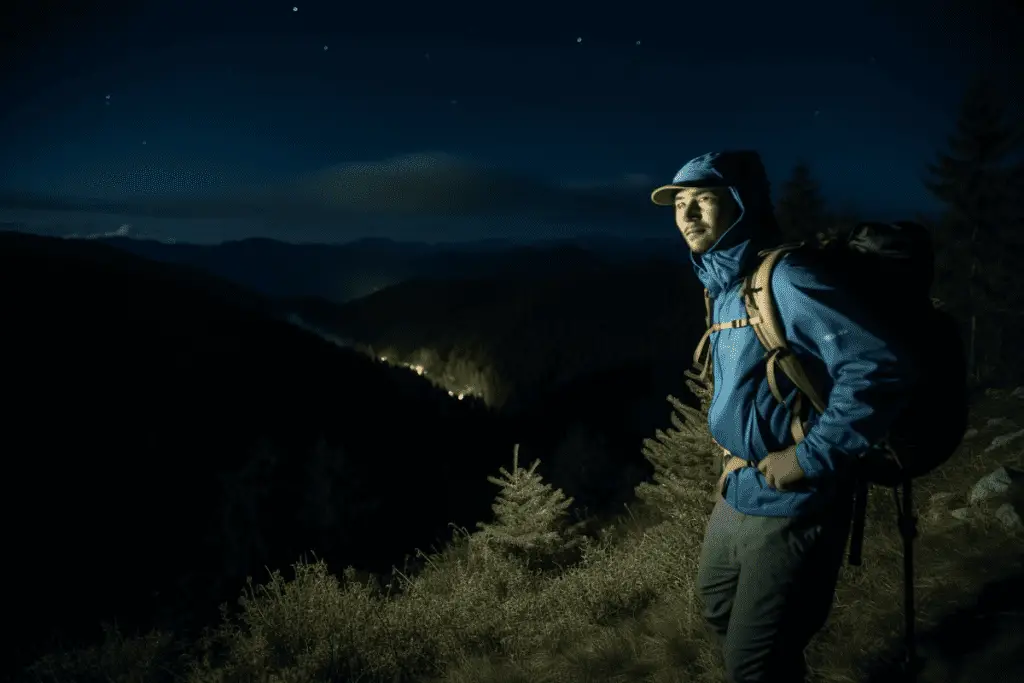
Why Choose Night Hiking Over Day Hiking?
Day hikes are awesome, there’s no arguing with that. But have you ever wished to escape the often crowded trails, the harsh afternoon sun, or simply want to mix things up a bit? If so, night hiking might just be the thrilling alternative you’re looking for.
First and foremost, there’s an undeniable element of magic and adventure that comes with hiking under the blanket of night. The world around you transforms, turning familiar sights into new discoveries. There’s a sense of tranquility, too, as the hustle and bustle of daytime fades away, replaced by the serene whispers of the night. This calmness can offer you a fresh perspective on your hiking experience, providing a mental break from our often overly stimulated daily lives.
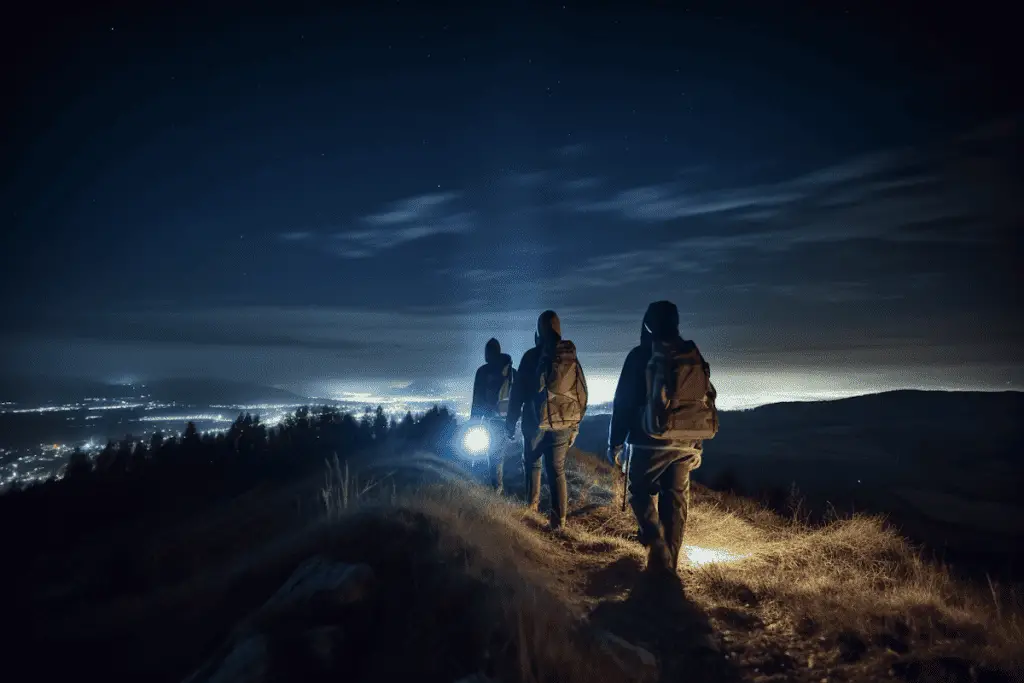
Then there’s the heat factor – or rather, the lack of it. For many, hiking in the hot sun can be taxing and uncomfortable. Night hikes offer a cooler alternative, making the journey a bit more pleasant, especially in the summer months.
And let’s not forget about the wildlife. Many animals are most active during dawn and dusk. So, night hikes can give you a unique opportunity to observe these creatures in their natural environment.
Finally, there’s something about the accomplishment of navigating a trail under the moonlight, a sense of victory that’s both unique and empowering. You’ll learn to trust your senses more, sharpening your awareness and enhancing your self-confidence. And, the sense of accomplishment isn’t the only health benefit to night hiking.
Health Benefits of Night Hiking
While we often talk about the thrill and adventure of night hiking, it’s also worth noting the numerous health benefits it offers. Night hiking isn’t just a journey for the spirit, it’s also a fantastic way to boost your physical and mental well-being. Let’s explore how your moonlit hikes are doing you more good than you might realize.
For starters, like all hiking, night hiking provides a robust cardiovascular workout. This helps to strengthen your heart and lungs, lower blood pressure, and boost your body’s metabolism. The changing terrain of hiking trails also builds strength and balance by engaging different muscle groups compared to flat-surface exercises.
The mental benefits of night hiking are equally impressive. Disconnecting from the digital world and immersing yourself in nature can help to reduce stress and anxiety. The quiet and solitude of the night can be a calming, meditative experience, helping to clear your mind and improve focus.
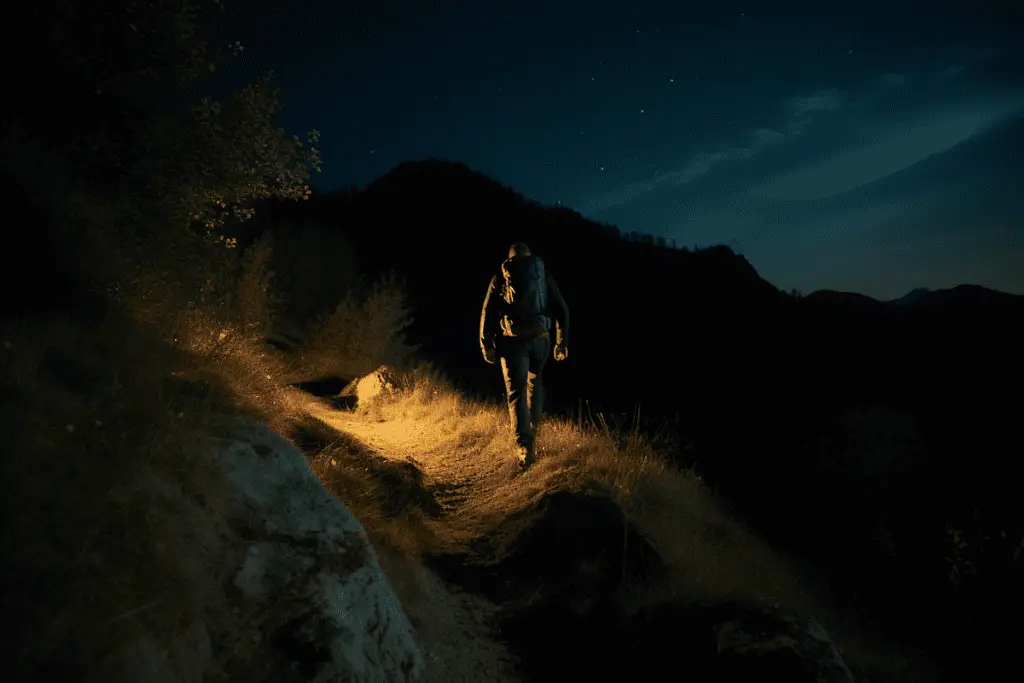
Night hiking can also help improve sleep quality. Exposure to natural light (even moonlight) and physical activity can help regulate your body’s sleep cycle, or circadian rhythm. Just remember to give yourself time to wind down after your hike before heading to bed.
In addition, night hiking can enhance your senses. In the darkness, you become more attuned to the sounds, smells, and feel of the natural world, sharpening your senses and awareness. This heightened sense of perception can carry over into your daily life.
Last, but not least, night hiking is a great way to boost your mood. The sense of adventure, the beauty of the starlit sky, the accomplishment of navigating trails in the dark – all of these can contribute to increased happiness and self-esteem.
Don’t get us wrong, day hiking isn’t going anywhere and still has its distinct charms. However, night hiking opens up a new horizon of experiences. Ready to give it a go? Let’s gear up and prepare for the adventure!
Essential Equipment for Safe Night Hiking
Venturing out into the wilderness after dark is undoubtedly exciting, but it requires some additional gear to ensure your safety and enjoyment. So, before you set out on your moonlit adventure, here’s a rundown of some key items you should pack.
Night Hiking Lighting
First off, you can’t go night hiking without a good source of light. Headlamps are a favorite among night hikers because they keep your hands free for navigating the terrain. Ideally, choose one with different brightness levels and a red light mode to preserve your night vision. Don’t forget to pack extra batteries or a portable charger!
Another handy tool is a handheld flashlight or lantern for additional lighting or to use as a backup. A backup light source is crucial in case your primary light fails.
Additional Night Hiking Essentials
A reliable navigation tool is a must. While you may be familiar with your trail, darkness can make the terrain confusing. A trail map and compass are basics, but a GPS device could also be a lifesaver. Remember, your smartphone might not have service in remote areas, so don’t solely rely on it.
Pack layers of clothing. Temperatures can drop significantly after sunset, so it’s important to stay warm. A hat, gloves, and a lightweight, insulating layer are generally good choices.
Last but definitely not least, always bring plenty of water and high-energy snacks. You’ll need to stay hydrated and fueled throughout your hike.
These are just the basics and depending on the location, length, and weather conditions of your hike, you may need to add more items to this list. Remember, the goal of any hike, day or night, is to get back home safely, so gear up appropriately and let’s hit those moonlit trails!
Choosing the Perfect Trail for Night Hiking
Finding the right trail for your night hiking adventure can make a huge difference. Not all trails are equal, and what might be a piece of cake during the day can become a whole different beast at night. But don’t worry, we’ve got some tips to help you pick the best trail for a safe and enjoyable moonlit journey.
Start with a familiar path. Choosing a trail you’ve hiked before during the daytime is a smart move for your first few night hikes. You’ll have a general sense of the layout, which can help you navigate in the dark. But remember, even a known trail can look and feel different at night, so stay alert!
Next, consider the trail’s complexity. Night hiking isn’t the best time to tackle technically challenging paths. It’s wiser to pick trails with fewer obstacles like steep cliffs or complex boulder scrambles. A well-marked and maintained trail will be easier to follow under the starlight.
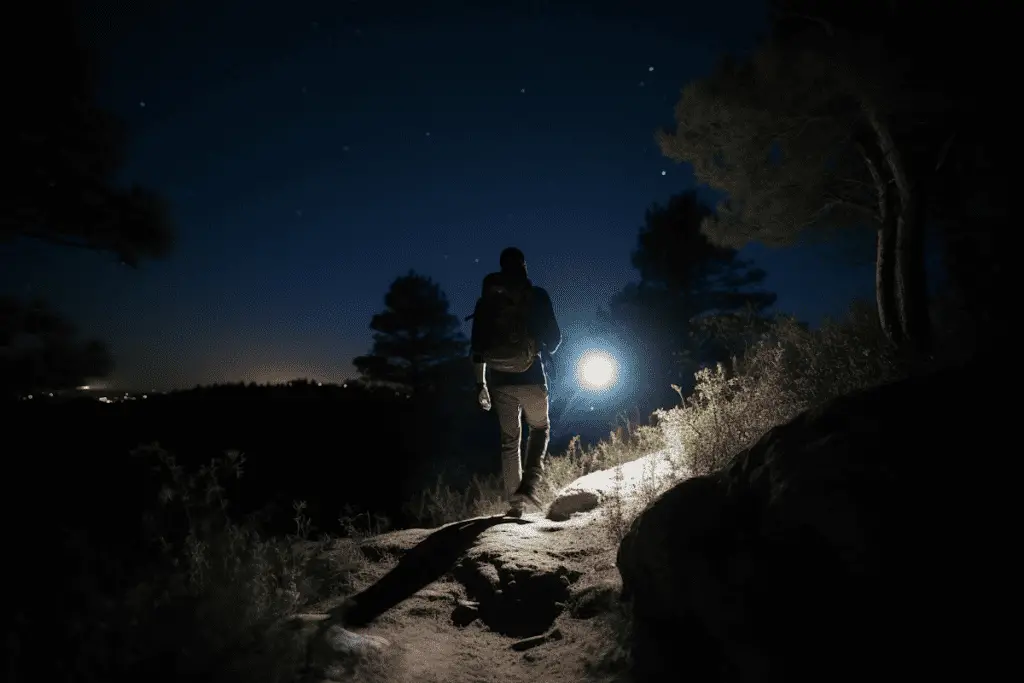
Take into account the trail length. Since visibility is reduced at night, your pace might be slower than it would be during the day. Choose a trail that you can comfortably complete within the time frame you have in mind, allowing for some buffer time in case of unexpected stops or slower progress.
Look for trails with open areas or overlooks. These spots are perfect for taking a break and soaking up the nighttime scenery, like a breathtaking view of the star-filled sky or a moonlit landscape.
Lastly, do your homework! Check out online reviews or local hiking groups for suggestions. They can provide invaluable insights into what trails are best suited for night hiking. Remember, the perfect trail is not just about the physical challenge, but also about your enjoyment and safety.
Reading the Night Sky: A Hiker’s Guide
If you’ve only ever stargazed from your backyard, prepare to have your mind blown. There’s something about being away from the city lights, enveloped by the wilderness, that brings the celestial dome alive in a way you’ve never seen before. But the night sky isn’t just a spectacle to behold, it can also be a helpful tool for navigation and understanding the passage of time.
One of the most identifiable patterns in the sky is the Big Dipper, part of the Ursa Major constellation. Finding the Big Dipper can help you locate the North Star, a reliable compass point for northern hemisphere hikers. Draw an imaginary line connecting the two outermost stars of the ‘cup’ of the Big Dipper, and extend it out about five times the distance between those stars, you’ll hit the North Star. This star stays almost stationary throughout the night, providing a constant reference point.
The Moon is another celestial body to be aware of. It can provide a significant amount of light, making night hiking easier. However, it can also outshine many stars, reducing the grandeur of the night sky. Be sure to check the lunar phase and moonrise times before your hike.
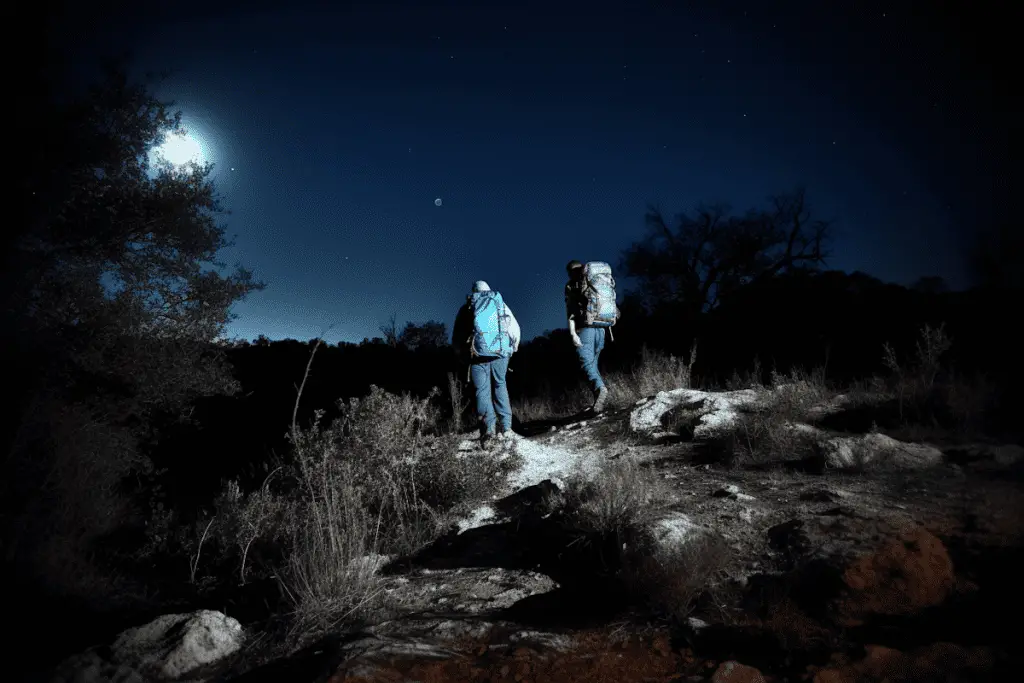
Don’t forget about the planets! Venus, known as the “Evening Star,” is often visible shortly after sunset or before sunrise, depending on the time of year. Jupiter and Saturn can also be visible to the naked eye and are great landmarks for stargazers.
Investing in a star chart app for your smartphone can be an excellent tool for learning to read the night sky. These apps use your phone’s GPS and internal compass to display a map of the sky at your location, identifying constellations, stars, and planets.
Remember, the more you familiarize yourself with the night sky, the more rewarding your night hikes will become. The sky is not just about navigation, it’s a beautiful tapestry that tells a story, and each night it has something new to reveal. So look up and let the stars guide your way!
Preparing for Unexpected Weather Conditions at Night
You know the saying, “Expect the unexpected”? This couldn’t be truer when it comes to night hiking. Weather can change rapidly, especially in mountainous or coastal areas, and nightfall often brings its own set of weather quirks. However, with a little planning and preparation, you can stay one step ahead of Mother Nature.
First, always check the weather forecast before you head out. Be aware of any impending storms, temperature drops, or shifts in wind patterns that might occur during your hike. Don’t be caught off guard by a sudden downpour or a dramatic temperature dip when the sun sets.
Next up, pack layers. Even if it’s a warm day, temperatures can plummet as soon as the sun goes down. An insulating layer and a waterproof jacket are absolute must-haves. Lightweight, moisture-wicking materials are ideal as they keep you warm without adding too much weight to your pack.
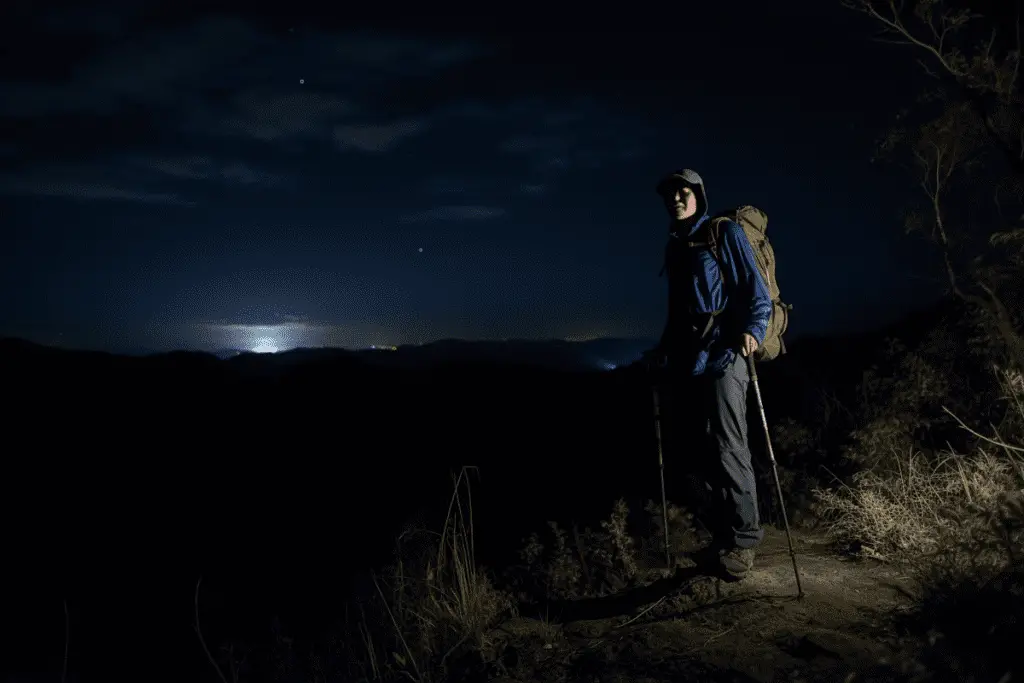
A good-quality, waterproof tent or emergency bivy can be lifesavers in a sudden storm or if you unexpectedly need to spend the night outdoors. These provide shelter and help retain body heat.
Not sure what a bivy is? Check out our guide to bivy camping!
Don’t forget about visibility. Foggy conditions or sudden rain can drastically reduce visibility. Pack a high-powered, waterproof headlamp or flashlight to help you navigate through these weather changes. Glow sticks can also be used to mark your path in case you need to backtrack.
Lastly, always let someone know your hiking plans. If the weather turns foul and you get stranded, someone knowing your whereabouts can be crucial to your safe return.
Nighttime Hiking Navigation: Techniques and Tools
Sure, hiking under a starlit sky sounds incredibly romantic, but let’s be honest – navigating in the dark can be quite the challenge. But fear not, fellow adventurer! With the right techniques and tools, you can safely find your way even when the sun decides to call it a day.
The first tool in your navigation arsenal is a good old map and compass. These classic navigational tools won’t fail you, even when your smartphone or GPS device does. But remember, using a compass is a skill, so it’s worth brushing up on your orienteering knowledge if you’re a bit rusty.
Speaking of GPS devices, they are incredibly handy for nighttime navigation. Modern hiking GPS units come loaded with detailed topographic maps, allow you to set waypoints, and track your path. Make sure your GPS is fully charged before setting off, and it’s always a good idea to pack an extra set of batteries.
Star navigation can also be useful, particularly in wide-open areas clear of trees or tall structures. As we mentioned earlier, learning to locate the North Star is a helpful skill. There are also numerous smartphone apps that can help you identify constellations and other celestial bodies.
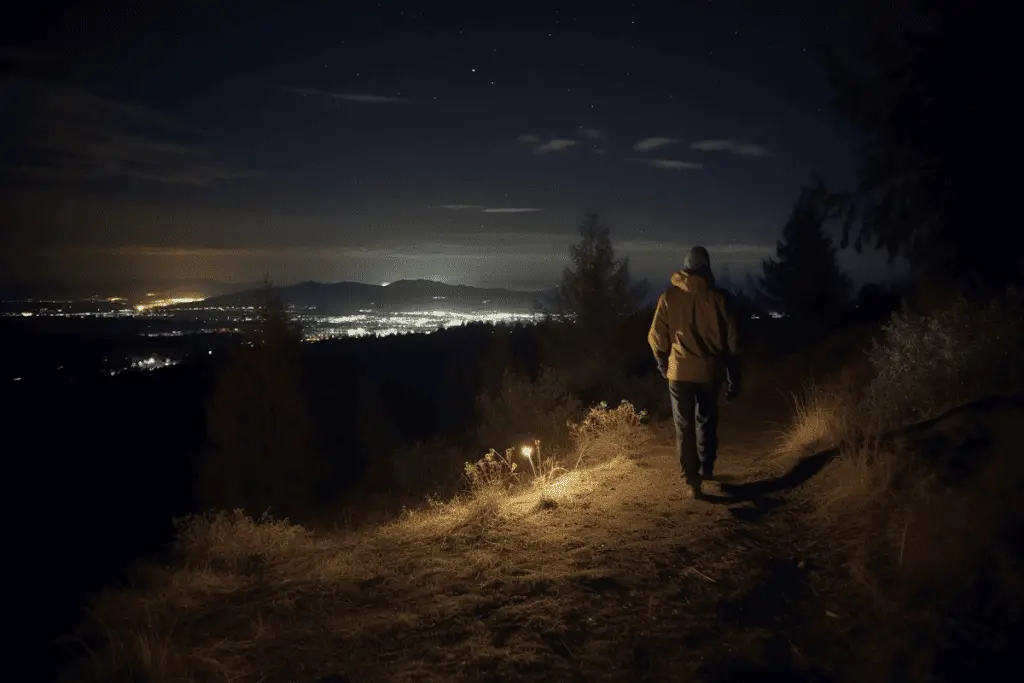
Trail markers are another critical element of nighttime navigation. Reflective trail markers, if available, can be your best friends. They’re designed to reflect light from your headlamp, making them stand out in the darkness. If there aren’t any, you can use your flashlight to look for regular markers, signs, or distinct landmarks mentioned in your trail guide.
And finally, use your other senses besides sight. Listen to the sounds of running water or winds that might indicate a nearby river or open area. Feel the trail under your feet. Often, hiking trails are packed harder than the surrounding soil, allowing you to feel the difference underfoot even if you can’t see it.
Navigating at night is a different ball game, but with these tools and techniques, you’re sure to find your way. Always remember to stay alert, trust your instincts, and most importantly, stay safe while enjoying your night hiking adventure!
Safety Measures for Night Hiking: Precautions to Take
Night hiking is undoubtedly an exhilarating experience, but it does come with its own set of unique safety considerations. The dark can be disorienting and make the terrain more challenging to navigate. That said, with the right precautions, you can make your nocturnal adventure safe as well as memorable.
First up, never hike alone at night. A buddy system is crucial for safety in case of an emergency. Plus, sharing the adventure (and the spookiness) is half the fun!
Before you head out, make sure someone who’s not in your hiking party knows your plan. Tell them your intended route, who’s with you, and when you expect to be back. This way, if something does go wrong, someone knows where to start looking.
Always have a well-stocked first aid kit in your pack. It should include basics like bandages, antiseptic wipes, tweezers, medical tape, and any personal medication. Accidents can happen, so being prepared is key.
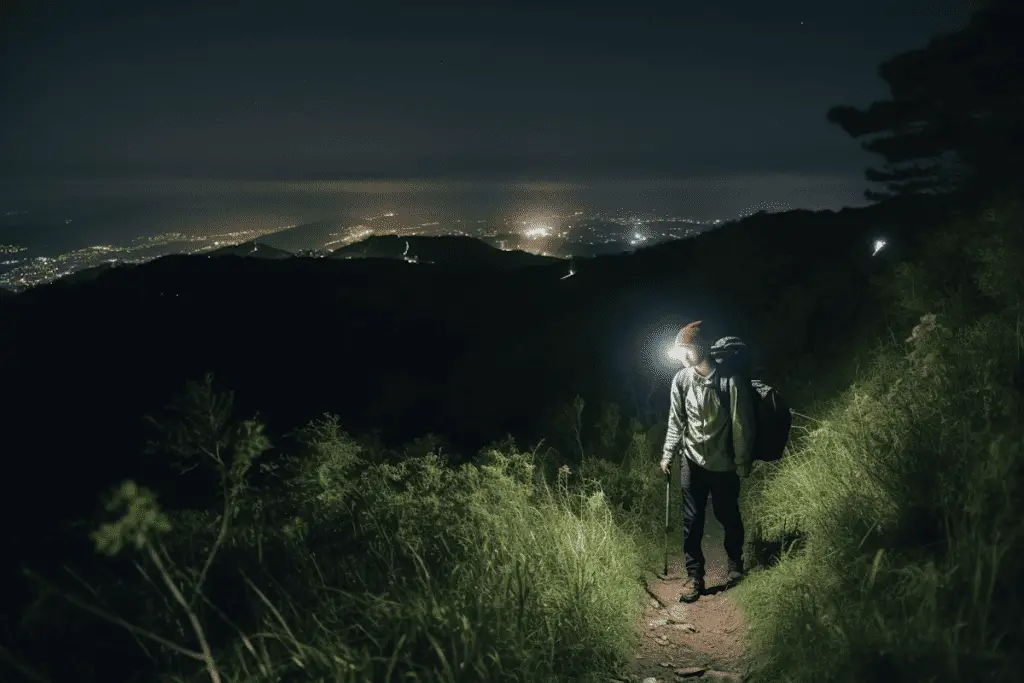
Proper lighting is essential. As we’ve mentioned before, a headlamp is an excellent tool as it leaves your hands free. Don’t forget to pack extra batteries or a backup light source.
Stay on marked trails to avoid getting lost or inadvertently wandering into a potentially dangerous area. This is not the time to go off-road and explore that tempting side trail.
Lastly, respect wildlife and give them space. Many animals are active at night, and startling them can lead to dangerous situations. Learn about the local wildlife, how to avoid encounters, and what to do if you come across any creatures on your hike.
Night hiking does require a higher level of care and preparation compared to daytime excursions, but it doesn’t mean it’s any less safe. By taking these precautions, you can ensure a thrilling, memorable, and safe night hiking experience.
Wildlife Encounters After Dark: What to Expect
When the sun goes down, the wilderness comes alive in a whole new way. Many animals are nocturnal, meaning they’re most active at night. While a wildlife encounter can be an exciting highlight of your night hike, it’s important to know what to expect and how to handle these situations.
You may hear the hoots of owls, the rustling of small mammals in the undergrowth, or even catch a glimpse of the reflective eyes of a deer caught in your headlamp. It’s a fascinating world, but one that requires respect and understanding.
Small mammals like raccoons, foxes, bobcats, and rabbits might be common sights on your nocturnal adventure. Remember to observe them from a distance, and never feed them. Feeding wildlife can disrupt their natural behaviors and diet.
In some areas, you might come across larger animals like deer, bears, or even mountain lions. If you’re hiking in such regions, do your research beforehand on how to react in case of an encounter. Making noise as you hike can help alert animals to your presence and avoid startling them.
Insect activity can also increase at night. Pack insect repellent and consider wearing long sleeves and pants to protect yourself from bites. Be mindful of where you place your hands and feet to avoid unwelcome surprises like spiders or scorpions.
Remember, the goal isn’t to avoid wildlife entirely – they’re a part of the unique charm of night hiking. The goal is to respect their space and ensure that any encounters are safe for both you and the animals.
The night is full of sounds, movements, and life. It’s a symphony of nature that you’re privileged to witness. So enjoy your nocturnal wildlife encounters, but always remember – we’re visitors in their world. Enjoy the show, but let’s not disturb the performers!
Packing a Night Hiker’s Survival Kit
As a night hiker, your backpack isn’t just carrying your gear – it’s carrying your safety net. Having a well-stocked survival kit is crucial. It doesn’t need to be heavy or bulky, just stocked with the right items that can make a huge difference if things go south. Here’s what you should consider packing for your nighttime adventure.
Pack an extra source of light, some extra layers of clothing, and an emergency blanket, bivy, or tent. Even a lightweight tarp that you can put up to get out of the rain could keep you from getting hypothermia.
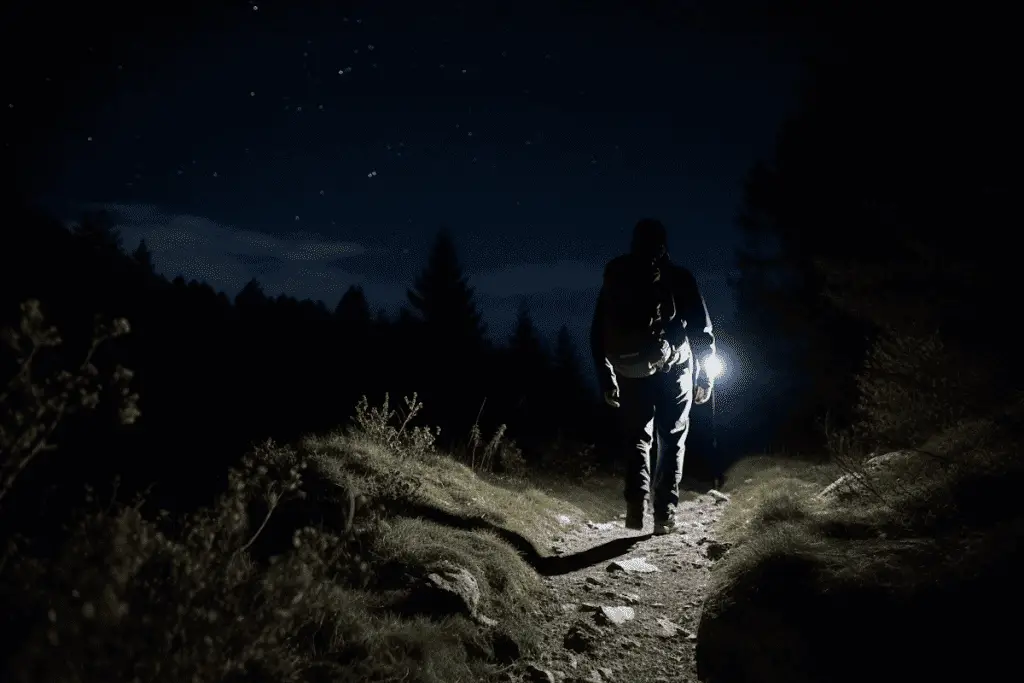
Extra food and water are also critical. Get lost at night and you could end up burning a lot of calories finding your way back the next day. I’d also suggest getting a portable water filter or at least a life straw that you can use in a pinch.
Lastly, pack a whistle and a set of glow sticks or a flare. These can be used for signaling in case you need help. A whistle blast is often more effective than yelling, and the glow sticks or flare can be seen from a distance. Just keep in mind that you shouldn’t use a flare in the woods or anywhere that could cause a fire. The only thing worse than being lost in the woods is being lost in the woods amidst a forest fire that you created.
Your survival kit is your lifeline in an emergency, but it’s also there to give you peace of mind. With a well-stocked kit, you can venture into the night knowing that you’re prepared for whatever the adventure brings.
Night Hiking Etiquette: Respect for Nature and Fellow Hikers
Navigating the wilderness under a star-studded sky is a privilege, and with it comes the responsibility of respecting nature and those sharing it with you. There’s a certain etiquette all night hikers should adhere to, ensuring the trails stay beautiful and enjoyable for everyone. Here are some key pointers to keep in mind.
Keep your group size small. Large groups can be disruptive, both to wildlife and to other hikers. If you’re hiking with a group, keep voices low and avoid unnecessary noise. Remember, many animals are nocturnal and your hiking adventure is happening in their home.
Practice “Leave No Trace” principles. Whatever you bring in, make sure you bring out. This includes trash, leftover food, and even biodegradable items like fruit peels. The goal is to leave the trail as you found it, or even cleaner if possible.
When it comes to lighting, less is more. Use your light source only when necessary and keep the beam pointed down to avoid blinding other hikers or disturbing wildlife. Red light is less disruptive to night vision, so consider using a headlamp with a red light setting.
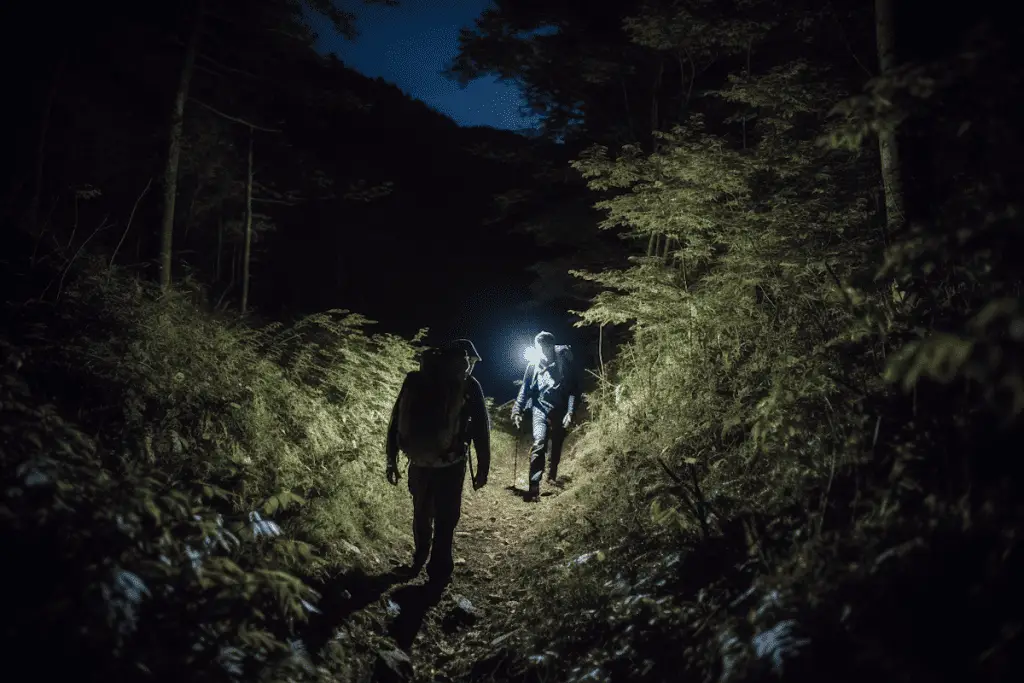
Stay on the designated trails. This protects the vegetation and helps prevent erosion. It also lessens the chance of an unexpected wildlife encounter.
Respect other hikers. If you come across other hikers, give them space on the trail and avoid shining your light in their eyes. If camping overnight, set up your camp away from the trail to give others room to pass.
Night hiking is an experience unlike any other, and following these etiquette guidelines ensures it stays that way for everyone. Respect for nature and fellow hikers isn’t just about rules, it’s about preserving the magic of the trails at night for generations to come. So lace up those boots, switch on your headlamp, and step into the adventure with care and consideration.
Night Hiking Checklist
Ready to go night hiking? I’ll leave you with this checklist you can use to help you prepare.
Gear:
- Backpack: Lightweight and comfortable, with enough capacity for your gear.
- Hiking Vest: Use instead of a backpack to hold your lights and other hiking gear.
Navigation:
- Trail Map: Even if you’re familiar with the area, a map is crucial when navigating at night.
- Compass: Always have a traditional compass as a backup to digital navigation tools.
- GPS Device: Handy for tracking your route, especially if it’s a new trail.
- Mobile Phone: Useful for emergencies and apps can help with navigation or identifying stars.
Lighting:
- Headlamp: Ideally one with a red-light setting to preserve night vision.
- Extra Batteries: Always pack extras for your headlamp or any other battery-operated gear.
- Backup Light: A compact flashlight or another headlamp can serve as a backup.
Safety and Survival:
- First Aid Kit: Should include bandages, antiseptic wipes, medical tape, tweezers, and personal medication.
- Whistle: Useful for signaling in case of emergency.
- Multi-tool: Useful for various situations, should include at least a knife and a pair of pliers.
- Emergency Blanket: Lightweight and can help keep you warm in case of unexpected situations.
- Fire Starter: Waterproof matches or a lighter, useful in emergency situations.
- Glow sticks or a Flare: For signaling in case you need to be found.
Clothing and Comfort:
- Warm Clothing: Layer your clothing to adapt to changing temperatures.
- Rain Gear: A lightweight, waterproof jacket or poncho is essential if the forecast is uncertain.
- Sturdy Hiking Boots: Choose ones with good ankle support and non-slip soles.
- Extra Socks: In case the ones you’re wearing get wet.
Food and Water:
- Water Bottle: Carry more water than you think you’ll need.
- Water Filter or Purification Tablets: Handy if you run out of water.
- High-Energy Snacks: Easy-to-eat foods like nuts, dried fruit, and energy bars.
Wildlife Safety:
- Insect Repellent: To keep bugs at bay.
- Bear Spray: Bear spray works on bears, mountain lions, wolves, coyotes, and many other potential predators.
Optional:
- Camera: To capture the beautiful night landscape.
- Star Chart or Sky Gazing App: To help identify constellations and planets.
- Trekking Poles: Helpful for balance and taking some strain off your knees.
Remember, the needs can vary based on the location, weather, and length of your hike, but this checklist should serve as a good starting point.
